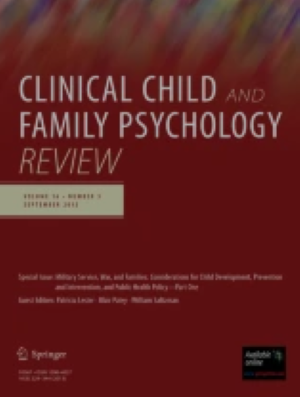Caught in the Web of the Net? Part II: A Motivation-Based Developmental Psychopathology Model for the Aberrant Internet Use in (Young) People with Autism Spectrum Disorder.
IF 6.1
1区 心理学
Q1 PSYCHOLOGY, CLINICAL
引用次数: 0
Abstract
In Part I (Muris et al. in Clinical Child and Family Psychology Review 22:549-561, 2025), we provided meta-analytic evidence showing that individuals with autism spectrum disorder (ASD) or high levels of autistic traits exhibit higher rates of problematic internet use (PIU), but paradoxically have lower levels of social media use compared to typically developing individuals or those with lower levels of autistic traits. The current theoretical article introduces a motivation-based developmental psychopathology model aimed at clarifying the motives behind the atypical internet and social media use observed in people with ASD or with high levels of autistic traits. We argue that excessive online activities, such as gaming and watching videos, can be understood through specific social, coping, and enhancement motives for internet use, which are especially prominent in ASD due to disorder-specific characteristics such as narrow interests and challenges in face-to-face interactions. In contrast, when it comes to social media use, these three motives operate differently, leading individuals with ASD to exhibit lower motivation to engage in online social interactions compared to neurotypical individuals. The current article emphasizes adolescence as a critical developmental period where internet use can easily become maladaptive and explores the role of parents in regulating the online behaviors of young people with ASD. Finally, the clinical implications of the model are briefly discussed.深陷网络之网?第二部分:一个基于动机的发展精神病理学模型:自闭症谱系障碍(年轻)患者的异常网络使用。
在第一部分(Muris et al. In Clinical Child and Family Psychology Review 22:54 -561, 2025)中,我们提供了荟萃分析证据,表明患有自闭症谱系障碍(ASD)或高水平自闭症特征的个体表现出更高的问题网络使用率(PIU),但与典型发展个体或低水平自闭症特征的个体相比,他们的社交媒体使用水平较低。目前的理论文章介绍了一个基于动机的发展精神病理学模型,旨在澄清在ASD患者或具有高水平自闭症特征的人群中观察到的非典型互联网和社交媒体使用背后的动机。我们认为,过度的在线活动,如游戏和观看视频,可以通过特定的社交、应对和增强互联网使用动机来理解,这在ASD中尤其突出,因为障碍的特定特征,如狭隘的兴趣和面对面互动的挑战。相比之下,当涉及到社交媒体的使用时,这三种动机的运作方式不同,导致自闭症患者与神经正常的人相比,表现出更低的参与在线社交互动的动机。目前的文章强调青春期是一个关键的发展时期,在这个时期,互联网的使用很容易变得不适应,并探讨了父母在规范自闭症青少年上网行为方面的作用。最后,简要讨论了该模型的临床意义。
本文章由计算机程序翻译,如有差异,请以英文原文为准。
求助全文
约1分钟内获得全文
求助全文
来源期刊

Clinical Child and Family Psychology Review
PSYCHOLOGY, CLINICAL-
CiteScore
10.50
自引率
4.30%
发文量
45
期刊介绍:
Editors-in-Chief: Dr. Ronald J. Prinz, University of South Carolina and Dr. Thomas H. Ollendick, Virginia Polytechnic Institute Clinical Child and Family Psychology Review is a quarterly, peer-reviewed journal that provides an international, interdisciplinary forum in which important and new developments in this field are identified and in-depth reviews on current thought and practices are published. The Journal publishes original research reviews, conceptual and theoretical papers, and related work in the broad area of the behavioral sciences that pertains to infants, children, adolescents, and families. Contributions originate from a wide array of disciplines including, but not limited to, psychology (e.g., clinical, community, developmental, family, school), medicine (e.g., family practice, pediatrics, psychiatry), public health, social work, and education. Topical content includes science and application and covers facets of etiology, assessment, description, treatment and intervention, prevention, methodology, and public policy. Submissions are by invitation only and undergo peer review. The Editors, in consultation with the Editorial Board, invite highly qualified experts to contribute original papers on topics of timely interest and significance.
 求助内容:
求助内容: 应助结果提醒方式:
应助结果提醒方式:


